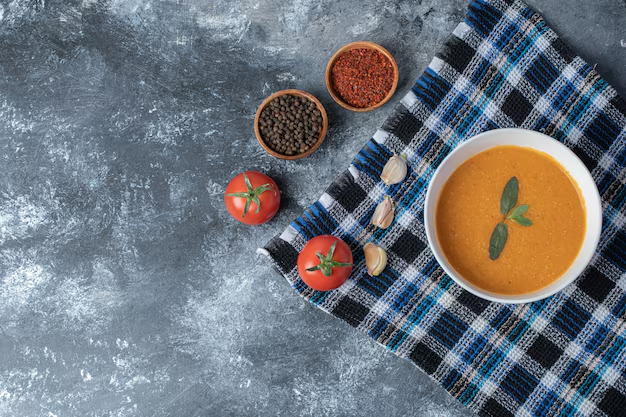How Long Can You Keep Gazpacho Fresh in the Fridge?
Discovering the vibrant, refreshing world of gazpacho can transform a hot summer day into a flavorful celebration. This cold Spanish soup combines the robust flavors of ripe tomatoes, peppers, cucumbers, and a hint of garlic, blended to perfection. Gazpacho not only offers a delightful taste experience but is also packed with nutrients, making it a favorite for many. But once you've prepared or purchased gazpacho, an important question arises: How long does gazpacho last in the refrigerator?
Keeping It Fresh: The Shelf Life of Gazpacho
When stored properly, gazpacho can last in the fridge for about three to five days. This timeframe allows you to enjoy its lively taste safely without concerns about spoilage. Several factors can influence this duration, so let’s dive into the essentials of keeping your gazpacho fresh.
Factors Affecting Gazpacho's Shelf Life
Several elements play a role in determining how long your gazpacho will stay fresh:
Ingredients Quality: Fresh, high-quality ingredients will extend the lifespan of your gazpacho. Overripe or low-quality produce can quicken spoilage.
Preparation Method: Blending the ingredients more finely can sometimes result in a quicker loss of freshness, as the flavors meld and deteriorate faster.
Storage Temperature: Keeping your refrigerator at a consistent temperature just below 40°F (4°C) can make a significant difference.
Storage Container: Always use an airtight container to prevent exposure to air and contaminants, which could lead to faster spoilage.
Signs Your Gazpacho Has Spoiled
While the general timeline is three to five days, it’s essential to use your senses to detect spoilage. Here’s what to look out for:
Smell: A sour or off smell is a clear indicator that your gazpacho has turned bad.
Texture: If the texture becomes too runny or separates entirely, it’s best to discard it.
Taste: A sour or fermented taste is a sure sign that it's no longer safe to consume.
Appearance: Mold growth or discoloration is an obvious indication of spoilage.
Enhancing Gazpacho's Shelf Life
To ensure you get the most out of your gazpacho, consider the following storage tips:
Store It Right
Use Glass Containers: Glass tends to maintain the flavor better than plastic and is less reactive with acidic ingredients like tomatoes and vinegar present in gazpacho.
Cold Storage: Always store gazpacho at the back of the fridge where it's coldest, away from temperature fluctuations near the door.
Consider Freezing
While traditional gazpacho purists might shudder at the thought of freezing this fresh soup, it's an option if you need to extend its life significantly:
- Freezing Tips: Portion the gazpacho into airtight containers or heavy-duty freezer bags. Leave space for expansion.
- Thawing Suggestions: Defrost overnight in the refrigerator. Blending or stirring it again before serving can help restore its texture and flavor.
The Foundation of Gazpacho: Understanding Its Ingredients
To appreciate the nuances of gazpacho's shelf life, it's useful to understand the ingredients making up this vibrant soup. Each component plays a vital role not only in flavor but also in determining freshness.
Main Ingredients and Their Impact
Tomatoes: The primary ingredient, rich in lycopene and vitamin C. Use fresh, ripe tomatoes for the best flavor and nutrient retention.
Cucumbers: Add a refreshing, hydrating crunch to the soup. As cucumbers contain a lot of water, they can affect the soup’s texture over time.
Peppers and Onions: Contribute spiciness and complexity, but can cause the flavor to turn if they begin to spoil.
Garlic: While adding zest, it can oversaturate flavors if left too long.
Vinegar and Olive Oil: These can act as natural preservatives, slightly extending the soup’s shelf life by preventing bacterial growth.
Variations That Can Affect Shelf Life
Fruit Gazpachos: Variations including fruits like watermelon or strawberries introduce different sugars, which can influence spoilage. These versions may have a shorter shelf life.
Herb Additions: Fresh herbs can add depth yet may wilt, impacting freshness.
Gazpacho's Nutritional Profile
Understanding the nutritional benefits of gazpacho can make the effort to preserve it worth it. Gazpacho is not only a low-calorie soup but also a powerhouse of vitamins and antioxidants, including:
- Vitamin C: Boosts the immune system and supports skin health.
- Vitamin A: Essential for vision and cellular growth.
- Antioxidants: Help in reducing inflammation and preventing chronic diseases.
Pro Tip: Consuming gazpacho soon after preparation maximizes nutrient intake, ensuring you enjoy its full health benefits.
Making the Most Out of Leftover Gazpacho
If your gazpacho is nearing the end of its freshness, don’t fret. Here are some creative ways to repurpose it:
Gazpacho Ice Cubes: Freeze in ice cube trays and use them to chill and flavor drinks.
Soup Base: Use leftover gazpacho as a base for other soups or sauces.
Marinade: Its acidity and flavor make it an excellent marinade for meats and seafood.
Key Takeaways: Gazpacho Storage Guide
Below is a concise guide to help you keep your gazpacho fresh and delicious:
- 🌡️ Temperature: Always store below 40°F (4°C) in the refrigerator.
- 🗓️ Best By: Use within 3-5 days for optimal flavor.
- 🔍 Check: Look for spoilage signs like off-smells, texture changes, and mold.
- ❄️ Freezing Option: Consider freezing if unable to consume in time.
- 🥄 Variety: Be creative with leftovers rather than discarding them.
By following these simple but effective tips, you can enjoy the refreshing taste of gazpacho without worry. Its vibrant flavors and nutritional benefits make every spoonful worth savoring, and with the right care, it’s a dish that can keep giving.
Embrace the culinary delight of gazpacho and keep it fresh, allowing this staple of Spanish cuisine to become a regular, healthy feature of your diet all summer long.
